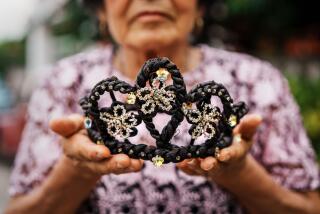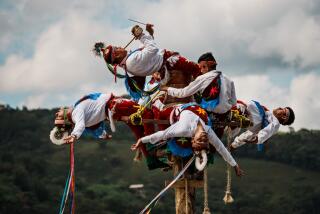Mexico’s Symbol of Unity : Devotions: The Virgin of Guadalupe solidifies a nation split by economic, social and political divisions.
- Share via
ZAMORA, Mexico — In Mexico, her image graces churches and cantinas, buses and taxis, union halls and corporate offices. She is heralded by the Bookies, a popular Mexican band, and by the country’s most famous poets. The Zapatista rebels in Chiapas display her on banners, and the wealthy build altars in her honor in their lavish homes.
The Virgin of Guadalupe--who is said to have first appeared before an impoverished Indian in 1531--has been called the emblem of the aspirations and hopes of the entire Mexican nation. In a country otherwise fractured by deep economic, social and political divisions, she remains an enduring national symbol of unity.
Mexicans are as faithful to the Virgin of Guadalupe as they are cynical about their political leaders. She is seen as the mother of the country, the interlocutor with Christ and the intercessor for the poor and the Indians.
Under her standard, the Mexicans fought the Spaniards in their battle for independence. And in Mexico’s Revolution of 1910, Emiliano Zapata led agrarian reformers to battle with her image on his flag.
“At the times of the greatest Mexican tragedies, the people always seek the Virgin of Guadalupe,” said Victor Gabriel Muro, a sociologist and specialist in contemporary religion at El Colegio de Michoacan.
According to legend, the Virgin first appeared in Mexico’s darkest hour, 10 years after the land was conquered by Spain and its Indian natives devastated by disease, defeat and the destruction of their entire religious cosmos.
According to early Catholic accounts, Juan Diego, a Christianized Indian, encountered the dark-skinned Virgin of Guadalupe on Tepeyac Hill, where she instructed him, in his native language of Nahuatl, to tell the archbishop to build a shrine in her honor.
Juan Diego pleaded with the virgin to find a more important emissary, but she offered her protection and love and told him he had been chosen to deliver her message.
*
As a sign for the skeptical archbishop, she had Juan Diego gather roses that had miraculously appeared on the hill’s desert slope. And when he opened his cloak to show the flowers to the archbishop, the virgin’s image appeared upon the cloth. The archbishop recognized the miracle and built the shrine.
The Virgin of Guadalupe then became the symbol of a new faith and identity for the Indians of Mexico. Her dark skin and Spanish features prefigured the founding of a new mestizo, or mixed Indian and Spanish race, and a new nation built from the joining of two cultures long divided by hate and distrust.
Adoration of the Virgin of Guadalupe, always an integral part of Mexican daily life, reaches its peak in this season, when a special day--Dec. 12--is set aside in her honor.
In the days leading up to the Dec. 12 fiesta, all of Mexico is transformed into a temple in her honor. Hundreds of thousands of people flock to her shrine at Tepeyac, in the northern part of Mexico City. Neighborhoods throughout Mexico are decorated with streamers and replicas of her image. And for 46 days before her fiesta--in honor of the 46 stars in the constellation on her cloak--the devout gather daily in front of neighborhood street altars to chant the rosary.
The evening and early morning of the Dec. 12 mark perhaps Mexico’s most important celebration. Children in Indian costumes dance all night from one street altar to the next. People spend the night in the streets, dancing, attending hourly Masses, and drinking a rich punch of tropical fruits and nuts.
On Dec. 12, people stream in and out of her temples, bringing fruit and flower offerings. Food stands that line the church square do a busy trade in pancakes with honey, fatty but delicious tacos made from the meat of a cow’s head, and tamales. And almost everyone, from employees of Pemex, the nationalized oil company that is the symbol of the corporate state, to flea market merchants, participates in elaborate processions in her honor.
This year, Alejandro Rodriguez Martinez, a Purepecha Indian, took his whole family on a half-day pilgrimage to the Zamora sanctuary to dance on Tuesday for the Virgin of Guadalupe. Dressed in the traditional costume and mask for the “Dance of the Old Ones,” he spoke in intimate terms of his relationship with the virgin.
“We came here to visit her,” he said. “This devotion is for her, so we can ask her to give us a few more years so we can continue dancing for her.”
Her appearance almost 500 years ago served as a symbol of Indians’ worth at a time when a fierce debate raged among Spaniards over whether Indians had souls--and a place in society--or were little more than animals fit for slavery.
Shortly after her appearance, missionaries began to succeed in converting the previously resistant Indians. But it is difficult to say whether worship of the Virgin of Guadalupe represents a victory for the conquered or the conqueror.
Indian converts transformed her into a figure that mirrored one of their own goddesses, Tonantzin, the mother of all Indian deities, who had been worshiped from the hill where the virgin was first seen. And early church accounts complained of the unholy blending of religious beliefs among Indian followers.
“Now that the church capital of Our Lady of Guadalupe has been built there, they call her Tonantzin too,” Spanish Friar F. Bernardino de Sahagun wrote 50 years after the conquest. “It seems to be a satanic invention to mask idolatry.”
Today, ordinary people say they cherish the Virgin of Guadalupe for her miracles. She is their mother, they say, and their protector.
“I have such a great love for her that words fail me,” said Margarita Esteban Aguilar, who lives with her family in a hut with a tin roof and dirt floors. “For someone who is poor,” she said, “nothing else remains but to ask for her help.”
And as most Mexicans are despairing over their country’s future and losing faith in their political institutions, the virgin continues to capture the imagination and faith of the nation.
“As happened 500 years ago, amidst the destruction came the light. In the midst of conflict, hope,” said Armando Flores, a sociologist and priest at the Parish of the Miraculous Medallion in Zamora, Mexico.
In the central Mexican town of Zamora, Father Raul Ventura offered a similar message recently as two girls painfully journeyed on their knees from the portals to the altar of a giant sanctuary to the virgin.
“We are a very divided people,” he said. “There are the rich and the poor, the government and the people. We face the same problems as in 1531--profound divisions, a people who suffer and need an identity. Her message of unity, hope and the construction of a new society remains relevant today.”
More to Read
Sign up for Essential California
The most important California stories and recommendations in your inbox every morning.
You may occasionally receive promotional content from the Los Angeles Times.













